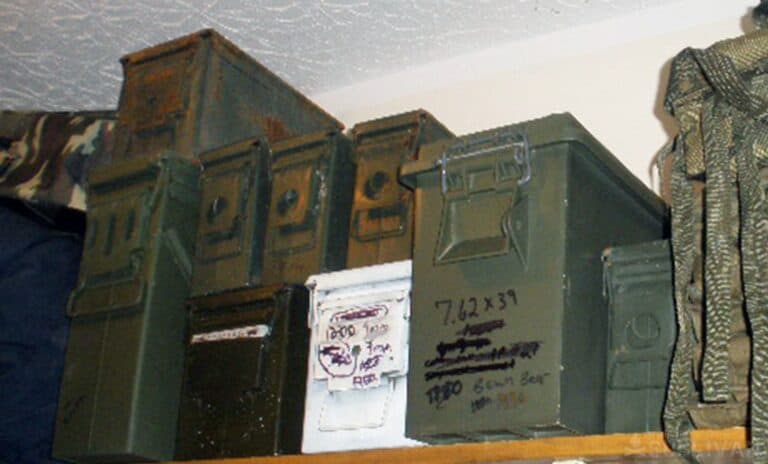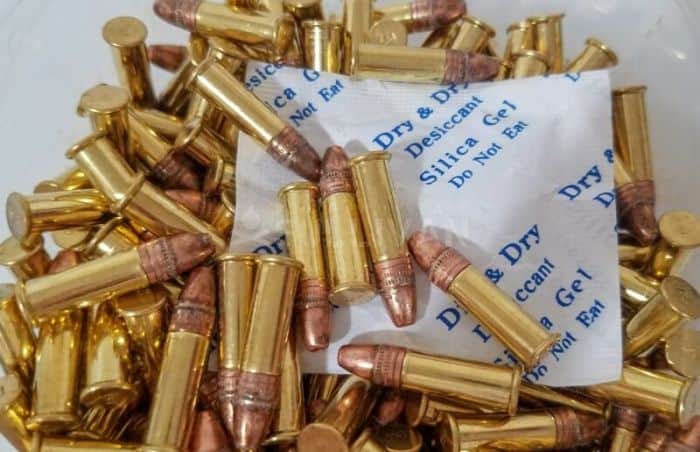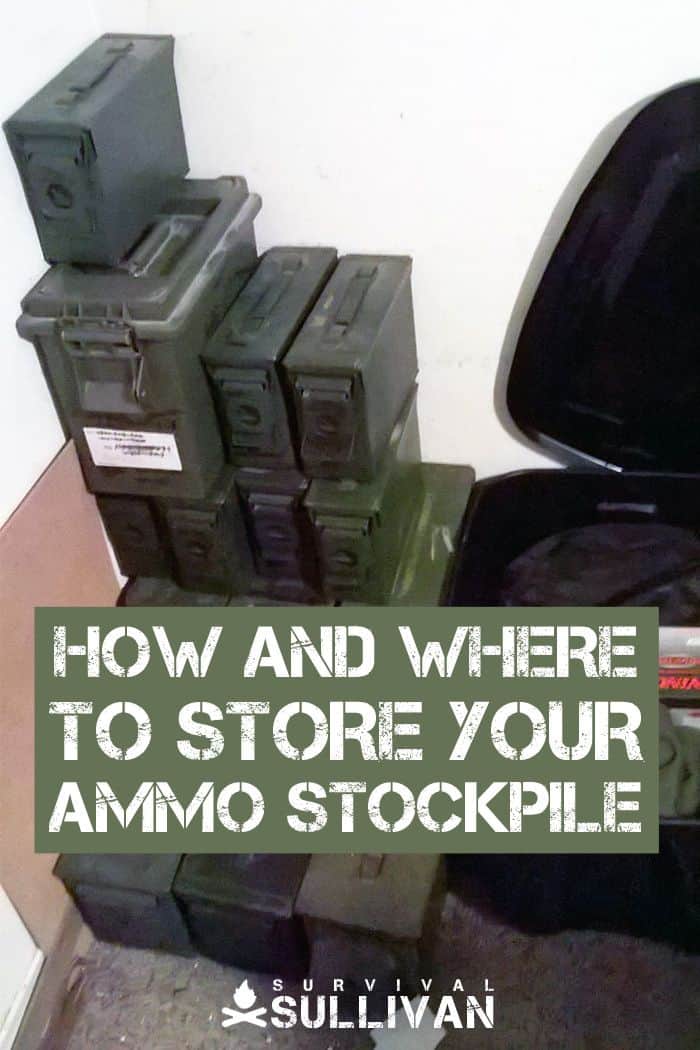When your gun doesn’t have the ammunition required to fire it, it’s little more than a poor club. While firearms provide any person with the best means of self-defense and security in a survival situation, they’re borderline useless without working a huge impact on how well your ammo.

This is why investing just as much money into a stockpile of ammunition is equally as important as investing money into a stockpile of food, water, gasoline, first aid supplies, and other equipment. In fact, most of the money that you spend on security should be spent on ammunition more so then on the guns themselves.
If you’re given the option between buying two guns or one just one gun and then spending the money that you would have spent on the second gun for ammunition, buying the gun and the ammo is always going to be the wiser choice.
So simple enough, right? Simply save up your cash and then head out and buy an entire shopping cart full of ammunition and you’re set…or so you may think.
The reality is that you need to dedicate just as much time and attention to storing and maintaining your ammunition as you dedicate to storing and maintaining your firearms.
The condition of your ammunition will have a huge impact on how well your gun functions. In fact, ammo that is stored poorly can be a major safety hazard and not only ruin your firearm, but potentially lead to a major injury as well.
This is why you need to take the steps necessary to store your ammunition in the right conditions so that you can preserve it well and ensure that it functions just like new several years down the road. That’s what we will cover in this article.
Table of Contents
WHAT IS THE AVERAGE SHELF LIFE OF AMMUNITION?
No ammunition has an indefinite shelf life, meaning that it will deteriorate and go bad eventually. Nonetheless, by taking the basic steps that we will cover in this article, you can prolong the shelf life of your ammo as long as possible.
Using the steps this article will cover, it’s perfectly possible for your ammunition to last at least ten to twelve years under proper storage conditions before it starts to show signs of corrosion.
HOW MUCH AMMO SHOULD YOU STOCKPILE?
You should ideally stockpile as much ammunition as you can reasonably afford and have enough space for storing. As a general rule of thumb, however, you should have at least one thousand rounds of ammunition per caliber in your stockpile.
Ammunition is not cheap, and a thousand rounds per caliber (or at least per caliber that you use the most often) may sound like an expensive endeavor.
However, no one’s saying that you should buy all of this ammo all at once. Instead, you can make it a habit to buy one or two boxes a week and then see your stockpile steadily grow from there. Besides, one to two boxes of ammunition a week is not going to take a very big bite out of your wallet at a time.
The cost will add up, but it’s easier to pay twenty or thirty dollars a week for a box of ammo than it is to lay a few hundred or even over a thousand dollars all at once for a larger stockpile.
A thousand rounds of ammunition per caliber is a good count to shoot for because it guarantees that you will have plenty in the event of a disaster, and not only for your own use but potentially for bartering purposes as well.
Ammunition will almost definitely be a major currency when SHTF, especially if there is a major anarchist revolt due to the disaster. In a lawless community, the area where you live could very well turn into an area much like the “Old West”.
Back in those days, people used to use bullets from their revolver to purchase shots of alcohol. This is why it’s called a shot, because one small glass of whiskey cost roughly the same as a “shot” for a revolver. I bet you didn’t know that, did you?
HOW TO STORE YOUR AMMO
All of your ammunition should be stored in a metal ammo can that is air and water tight.
Ammo cans come in a variety of sizes, but the 50 caliber cans are easily the most versatile because they can carry a respectable amount of ammunition without becoming too heavy to the point that they can’t be carried over long distances.
A .50 caliber ammo can should easily be able to store at least two hundred shotgun shells, five hundred center fire rounds, and two thousand .22 LR rounds.
These ammo cans come with a sealant around the edges that works miracles at resisting air and water; you can even submerge the cans completely underwater and assuming the sealant is in good condition, the contents inside will be completely dry.
It’s still a good idea for you to toss a dry packet or two in each can to reduce condensation:

If you want your ammunition to stay clean and dry, ammo cans are the way to go.
But the next question is where you should store each ammo can. If each can is really able to resist water and oxygen, then you should be able to store the cans practically anywhere, right?
Not exactly. You still need to store your ammunition in an optimal environment if you want to prolong the shelf life of the ammo inside to those ten or twelve years.
To be more specific, your ammunition should be stored in a location that is safe and secure, has low humidity, and is at a stable room temperature.
An added safeguard for your ammunition if it’s stored for long periods of time, is vacuum sealing. If you plan on storing bulk ammunition for long periods of time, especially in a bug out location, you should look into vacuum sealing your ammunition.
Once it’s vacuum sealed, place it back in the ammo can and drop a few dry packets inside of the can. This way, you have three safeguards in one.
Be careful about storing ammunition at your bug out location if the climate can be extremely cold, or extremely hot during certain seasons. The drastic change in weather can have a devastating effect on your ammunition over time.
SAFE AND SECURE LOCATION
You store your guns in a secure and safe location, right? Why wouldn’t you do the same with your ammo?
Not only does storing your gun in a safe and secure location ensure that it is protected from the elements, it also ensures that it is protected from being accessed by people who shouldn’t have it such as children.
Having a separate safe for your stored ammo isn’t a bad idea, but even if you can’t afford a safe or don’t have a large enough one, storing it in a locked room or up on a tall shelf so small children can’t reach it are precautions you should take. At the very least, you should be able to apply separate locks to your ammo cans.
Remember that the same responsibility you have for storing your firearms applies to your ammunition as well. You must take the same precautions and store them in the same manner.
LOW HUMIDITY LOCATION
The number one enemy of ammunition is moisture and humidity. Therefore, in addition to storing your ammo in a place that is safe and secure, it also must be stored in a place of little humidity.
When water or moisture gets on your ammunition for an extended period, it can corrode both the casing and the primer and make the ammunition simply unsafe to fire.
While storing your ammo in an airtight metal container will certainly help to keep the moisture away, you will want to take an extra precaution by storing those ammo cans in a room that already has low humidity.
You also need to double check your ammo cans before actually storing your ammunition inside of them to confirm that there is no moisture of any kind. Keeping desiccant packets in the cans also should keep your ammunition in good condition over the long term.
NORMAL ROOM TEMPERATURES
Modern ammunition is designed to function in all kinds of conditions ranging from frigid winter environments to a hot desert or tropical environment.
Nonetheless, this does not mean that ammunition can be stored in these kinds of extreme conditions over the long term and still be expected to be in optimal condition.
You will definitely want to avoid storing your ammo in a car, since your vehicle effectively serve as a heat trap. Heat that’s over a hundred and fifty degrees Fahrenheit can degrade your ammunition, especially the priming mixture and the gunpowder.
Extreme cold temperatures will not be as harmful to your ammunition as the elevated temperatures, but to be on the safe side it’s still a good idea to store your ammunition at normal room temperature. Rapid changes in temperature can degrade your ammo over time.
This rules out storing your ammunition in a garage, because garages can become very hot during a summer day and then very cold during the nighttime. If you store your ammo in a place at normal room temperature, or at least in a place where the temperatures will not vary significantly, you should be fine.
WHERE TO AND NOT TO STORE YOUR AMMO
Using this information, we can make a list of places to store and not to store your ammunition.
Places where you can store your ammunition include the following:
- Pantry
- Home office
- Root cellar
- Any dry room at a normal temperature
- Gun safe
Places where you should NOT store your ammo include the following:
- Outdoors
- Vehicle
- Attic
- Garage
- Outside Shed
LABEL AND ROTATE
You should always label your containers when you buy ammo and mark the container with the date the ammo was stored.
This will ensure that you always rotate the oldest ammunition out first. Always use the older ammo before the new ammo as well so that you have the freshest and newest ammo possible in your stockpile.
You should ideally conduct checks on your ammunition once every six months to a year. During these checks you will want to test the ammunition for humidity and temperature.
Place a humidity sensor card inside the ammunition can to confirm that the level of humidity is less than thirty percent. You should also replace desiccant packs during this time and visually inspect the ammo yourself to look for any signs of corrosion or discoloration.
CONCLUSION
As you can tell by the information in this article, storing your ammunition is vitally important but it is also incredibly simple as long as you follow the basic guidelines I listed above.
This means keeping your ammunition in a safe and secure location that also protects it from exposure to humidity, moisture, and extreme or rapid changes in temperature.
If you take your preparations for survival and disaster seriously, you must know how to store all of your ammunition correctly over the long term. If you do not, all of the money that you spent on your ammo will have been wasted and more critically your firearms will become little more than useless clubs.
This is why learning basic ammo storage techniques to prolong its shelf life could mean the difference between life and death for when you have to defend yourself.

update by Reaper 01/08/2018

Nick Oetken is a prepper, outdoor enthusiast but, most of all, he is our in-house firearms expert. Look out for his articles on guns to find out which ones you need for your survival.

I recently came across some Remington 22 lr that I purchased in 1968. I took it to the range and shot 50 rounds without a misfire. Most of the years in storage were in a dry cool location in a metal 50 call ammo box.
VACUUM SEALING AMMO PLIS PUTTING IT IN AMMO CANS WITH O2 ABSORBER IS PROBABLY THE BEST METHOD THAT WILL ENSURE QUALITY AMMO FOR DECADES TO COME